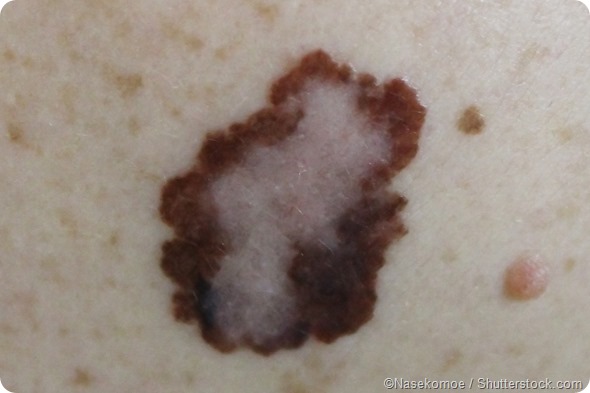Internal malignancies such as cancers can develop external signs on the skin called cutaneous markers or manifestations. These signs may show prior to, during, or after a cancer has been detected. At times they can indicate the development of an undiagnosed cancer in the body – this would be considered particularly useful if determined before the cancer was to reach an advanced stage.
Sometimes the internal malignancy may be directly involved with the skin such as in skin cancers or may present as numerous signs indicating a specific disease – a syndrome. It is possible for a specific organ to be impacted which may result in signs such as jaundice.
Leukemia cutis
This presents as single or multiple lesions on the skin that can be itchy. They are the result of the excessive production of white blood cells symptomatic of the blood cancer leukemia. It can affect approximately 3% of people with leukemia.
Cutaneous metastases
This skin condition is usually diagnosed after the initial diagnosis of a primary cancer and can be caused by cancer cells spreading from this location to the skin through the blood or lymphatic system.
The chance of developing metastasis in the skin varies depending on the type of cancer and also whether the patient is male or female. The most common form of metastasis is melanoma followed by breast cancer and nasal sinus cancers.

Melanoma on the skin
In breast cancers, the skin shows signs in the chest and abdominal areas. In lung cancers, the areas affected usually include the chest, abdomen and back. There are sex-specific differences in melanoma - in men, the chest, back and extremities can show skin disease whilst in women, the lower areas of the body are affected. In colon and stomach cancers, the abdominal and pelvic areas can develop nodules.
In men below the age of 40, melanoma is the most likely cancer form to produce metastasis followed by colon cancer and lung cancer in order of decreasing frequency. In men over 40, lung cancer is most likely to result in metastasis followed by colon cancer and squamous cell carcinoma.
In women below the age of 40, breast cancer is the most form of cancer to cause metastasis with colon cancer and ovarian cancer the next most likely. Above the age of 40, breast cancer remains the most common with colon cancer and lung cancer next.
Paraneoplastic syndromes
Acanthosis nigricans (AN)
This is a skin condition that can appear up to five years before other signs of a disease develop. It appears as a hyperpigmentation and thickening of the skin in areas that are prone to frequent rubbing. It can also be found on the scalp, areolae and eyelids. It is associated with cancers of the gastrointestinal tract such as those of the stomach and liver. Other cancers that it can indicate include breast, kidney, lung and prostate. It has also been linked to non-cancerous conditions such as endocrine disorders and insulin resistance.
Acrokeratosis paraneoplastica (Bazex syndrome)
In this condition the skin develops symmetrical, scaly plaques on the extremities of the body such as the toes, finger tips, elbows, knees, knuckles, heels and ears. It has the appearance of psoriasis. The patient can also develop alopecia, hair loss and flaky nails. Symptoms can present up to one year prior to the diagnosis of the disease. It is linked to head and neck cancers. The skin can heal with successful cancer treatment.
Acquired ichthyosis
In this condition, small, polygonal scales form on the trunk and extensor muscle surfaces at any time during the development of cancer. The disease is based on what is known of the history of the patient and clinical information. It is a sign of diseases such as Hodgkin’s lymphoma, leukemias and solid tumors in the bladder, breasts or lungs. Treatment involves treating the underlying disease that is causing the skin condition.
Dermatomyositis
This is an itchy rash causing erythematous lesions that develops in combination with inflamed voluntary muscles. More women than men tend to develop it and the condition is also more common in people between the ages of 50 and 70 years old, indicating the potential presence of cancer. It can develop on the knuckles, the face, especially creating a heliotrope rash on the upper eyelids. Patients can also feel some photosensitivity.
Paraneoplastic pemphigus
This presents as blisters on the skin in areas such as the mouth, esophagus and lips which can be very painful for the patient. It develops due to an autoimmune disorder which can cause damage to the respiratory and gastrointestinal areas. It also indicates a developing cancer therefore the treatment is through finding and resolving the specific cancer causing the condition.
References:
- DermNet Nz on cutaneous manifestations of internal malignancy: http://www.dermnetnz.org/systemic/malignancy.html
- Medscape on cutaneous signs and symptoms associated with internal malignancies: http://emedicine.medscape.com/article/1095113-overview#a1
- Guys and St Thomas NHS on genetic skin diseases: http://www.guysandstthomas.nhs.uk/our-services/dermatology/specialties/genetic-skin-diseases/overview.aspx
- NHS Choices on ichthyosis: http://www.nhs.uk/Conditions/ichthyosis/Pages/Introduction.aspx
- Medline Plus on ectodermal dysplasia: https://www.nlm.nih.gov/medlineplus/ency/article/001469.htm
- DermNet Nz on paraneoplastic pemphigus: http://www.dermnetnz.org/immune/paraneoplastic-pemphigus.html
- DermNet Nz on leukemia cutis: http://www.dermnetnz.org/dermal-infiltrative/leukaemia-cutis.html
- DermNet NZ on skin metastases: http://emedicine.medscape.com/article/1097702-clinical
Further Reading